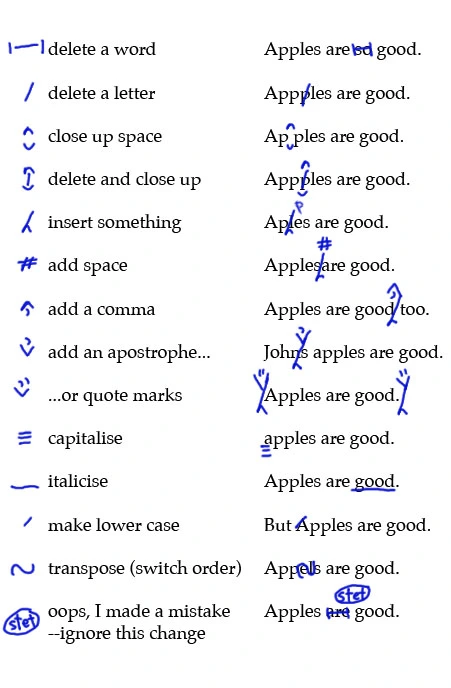Recently, I’ve encountered a few writer friends having small panic attacks because they’ve received notes from their editors that contain copyediting markup. You know, the weird symbols that editors scrawl in pen or pencil above your nice typed lines, or in the margins. As it happens, these are not arcane symbols, or their version of cursing you out in secret editor language. Each symbol means something different.
Once you know the basics, you’ll find that these symbols are actually extremely useful—both to decipher what your editor wants from you, or to use when proofing your own work by hand. In this post, I’ll give you a rundown of the most common editorial markup, and show you how to use/read it (I should, at this point, insert a disclaimer that I’m Australian, and I got my editing degree in Australia—while editing markup is the same in both countries, it is possible that there are minor differences I don’t know about. This post should still be useful, regardless).
First, some editing basics. Did you know that there’s a difference between copyediting and proofreading? Well, there is. Copyediting and proofreading use most of the same editing symbols, but their placement and practical use is quite different. For this post, I’m going to focus on copyediting markup. It’s simpler to understand, and you’ll still be able to apply this knowledge to proofing. But if there’s interest, I can do another post next year on how to decipher a proofread manuscript. For now, here are the basic differences between copyediting and proofreading.
Copyediting is undertaken earlier in the editing process. The easiest way to distinguish copyediting is by sight. Has the editor written full markup above each (usually double-spaced) line? Then it’s copyediting. There’s often far more copyediting used per manuscript than proofreading, mainly due to their different places/functions in the production timeline. Copyeditors will check your grammar, yes, but that’s only one part of their job. They also screen your manuscript for inconsistencies, logic holes and continuity errors. We’ve all accidentally swapped the spelling of a character’s name halfway through a manuscript, or changed our minds about italics so many times that you switch back and forth every chapter. It’s a copyeditor’s job to catch that. If they’re copyediting by hand, they use editing symbols to note these problems.

Proofreading is marked both in-text and in the margins of a nearly completed book. Different symbols are used for each position. When proofreaders (often hired as freelancers outside the publishing house structure) are assigned a manuscript, it will be formatted—with fancy chapter titles and page numbers and the fonts that will be used in the published version. Basically, proofreaders are the last defence between your book and nitpicky readers who’ll never let you forget that you used the wrong possessive plural form of ‘teachers’. They check everything they see, including formatting. When proofreaders read a manuscript, they put their requested changes in the margins of each page. This is partly because the proofs they’re working from don’t usually have space for much on the line markup. It’s also so the typesetter can spot their (often minimal) changes.

Now, on to the marks themselves! I’m only including the most common marks here, but feel free to ask questions if you want to know more. A quick note—you may see some slight variations in the marks your editor uses. This is totally normal. Every editor tends to develop their own style, like handwriting.
Ahem:


Okay! Hopefully that wasn’t overwhelming. Personally, I find using editorial marks pretty fun, but that might just be me… Regardless, this should be a useful, basic guide for any panicking writers!
If any US editors are reading, I’d be curious to know if you spot any differences in the way we do things. For the rest of you, please let me know if you have any questions—or if your editor’s scrawled something indecipherable in your margins and you need a translator!
Until then, good luck!
